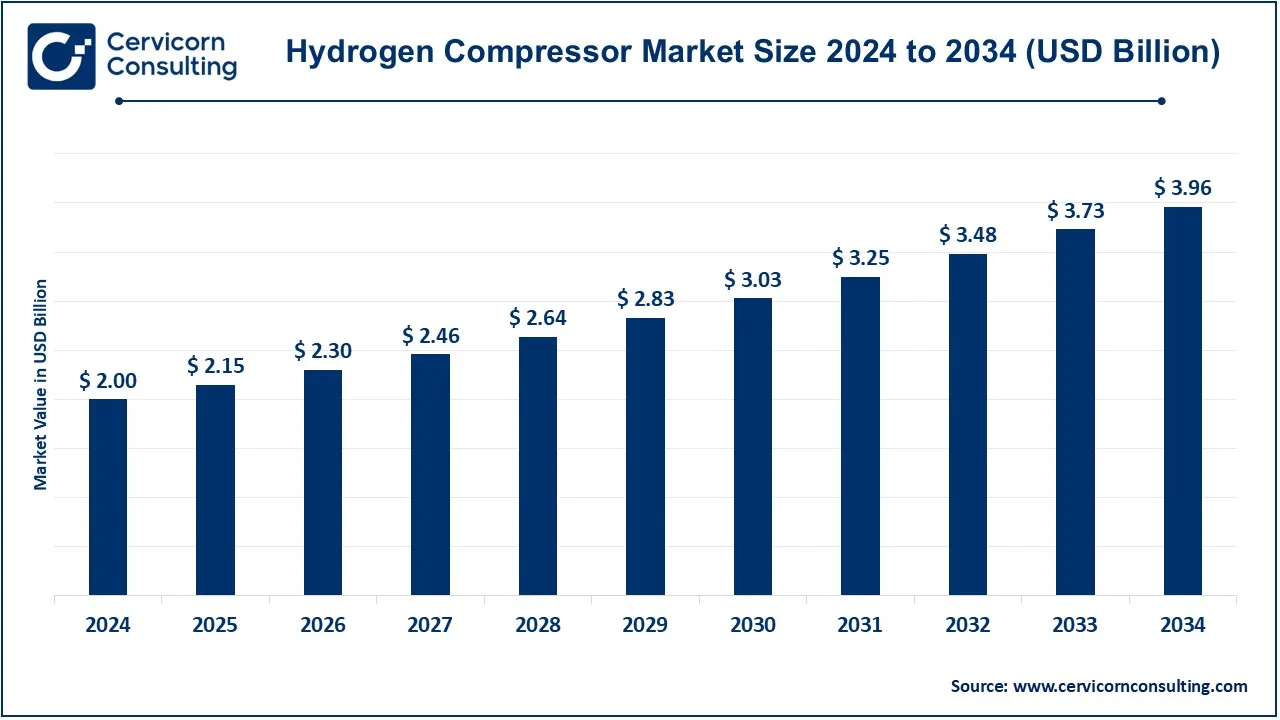Hydrogen Compressor Market Overview
The global hydrogen compressor market plays a pivotal role in the hydrogen energy ecosystem, facilitating the efficient compression, storage, and transportation of hydrogen for industrial, mobility, and energy applications. These compressors are essential for fuel cell vehicles, power generation, chemical processing, and renewable energy integration (source).
Valued at approximately USD 2 billion in 2024, the market is expected to reach around USD 3.96 billion by 2034, growing at a CAGR of 7.14% from 2025 to 2034. The growth trajectory is driven by the rising adoption of hydrogen as a clean energy solution and increasing investments in green hydrogen infrastructure worldwide.
Key Market Trends
-
Electrification of Hydrogen Compression
-
The market is witnessing a shift from traditional mechanical compressors to electrically driven systems.
-
Electric compressors enhance operational efficiency while reducing carbon emissions.
-
Example: Advanced systems integrating variable frequency drives and intelligent control technologies are becoming more prevalent.
-
-
Integration with Renewable Hydrogen Production
-
Compressors are increasingly paired with electrolyzers powered by solar and wind energy, enabling efficient green hydrogen storage and distribution at refueling stations and industrial facilities.
-
-
Use of Advanced Materials for Durability
-
Lightweight alloys and corrosion-resistant components enhance compressor lifespan and reduce maintenance needs.
-
Example: Titanium and stainless steel are now standard in high-pressure hydrogen compression systems.
-
-
Regulatory Support and Safety Standards
-
Governments worldwide are implementing regulations to promote hydrogen infrastructure, encouraging market expansion.
-
Adherence to ISO 15500 and ASME codes ensures safe operations and builds market confidence.
-
-
Expansion of Hydrogen Mobility
-
Growth in fuel cell electric vehicles (FCEVs) drives the demand for high-pressure hydrogen compressors.
-
Example: Hydrogen refueling stations across Europe, North America, and Asia-Pacific are scaling up their compressor capacities.
-
Market Drivers
-
Rising Hydrogen Adoption
-
Global decarbonization initiatives across industries and transportation sectors are accelerating hydrogen demand.
-
Increasing hydrogen refueling stations and industrial pipelines support compressor market growth.
-
-
Government Policies & Incentives
-
Supportive policies, tax incentives, and infrastructure funding boost market adoption.
-
Example: The EU Hydrogen Strategy and funding from the US Department of Energy (DOE) for hydrogen hubs.
-
-
Technological Advancements
-
Ongoing R&D in high-pressure compression, energy-efficient operations, and leak prevention improves performance.
-
Digital monitoring systems enable predictive maintenance, reducing operational costs.
-
-
Industrial and Mobility Applications
-
Hydrogen adoption is rising in chemical, steel, and refinery sectors for cleaner production.
-
Expansion in FCEVs, buses, and trucks increases demand for reliable compressors.
-
Quantitative Insight: With global FCEV adoption on the rise, the number of hydrogen refueling stations is projected to exceed 2,000 by 2030, fueling compressor demand.
Impact of Trends and Drivers
-
Regional Impact:
-
Asia-Pacific leads due to large-scale FCEV adoption and supportive policies in Japan, South Korea, and China.
-
Europe experiences steady growth via green hydrogen investments and regulatory frameworks.
-
North America benefits from DOE-backed initiatives and private sector investment in hydrogen infrastructure.
-
-
Segment Impact:
-
High-pressure compressors for mobility applications are the fastest-growing segment.
-
Low- and medium-pressure compressors remain essential for industrial hydrogen storage and processing.
-
-
Application Impact:
-
Strongest adoption is seen in fuel cell vehicles and hydrogen refueling stations.
-
Industrial pipelines in steel, chemical, and fertilizer sectors increasingly rely on advanced compression solutions.
-
Challenges & Opportunities
Challenges:
-
High capital expenditure for advanced compressors.
-
Safety and regulatory compliance requirements may slow deployment.
-
Lack of standardized hydrogen infrastructure across regions.
Opportunities:
-
Integration with renewable hydrogen production presents significant growth potential.
-
Technological innovations in energy-efficient compressors can reduce costs and expand adoption.
-
Emerging markets such as India, Brazil, and the Middle East offer untapped opportunities.
Future Outlook
The hydrogen compressor market is set for steady growth, fueled by global decarbonization goals and expanding hydrogen technology adoption. The market is driven by high-pressure compressors for mobility, integration with green hydrogen projects, and government-backed infrastructure programs. Innovations in electrification, advanced materials, and digital monitoring will continue to shape the market, presenting significant opportunities for manufacturers and investors in the hydrogen economy.
📌 Contact for Detailed Market Insights: https://www.cervicornconsulting.com/contact-us

